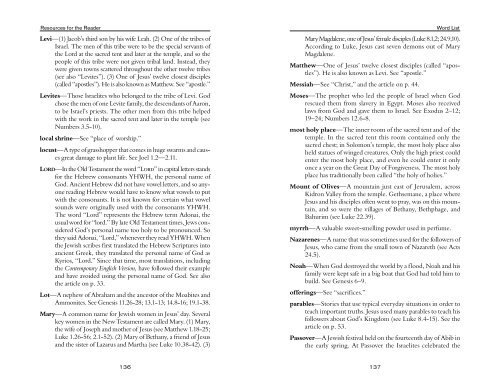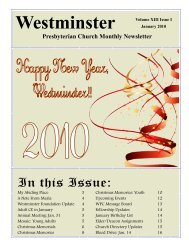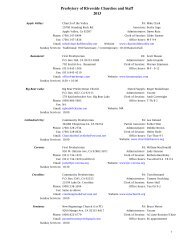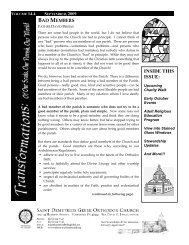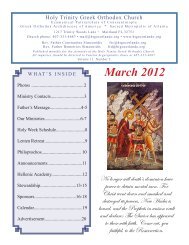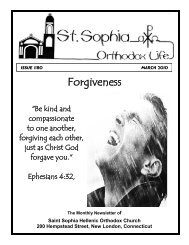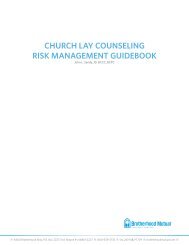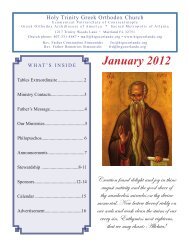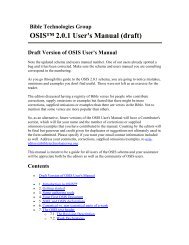The Life of the Christ - ForMinistry
The Life of the Christ - ForMinistry
The Life of the Christ - ForMinistry
You also want an ePaper? Increase the reach of your titles
YUMPU automatically turns print PDFs into web optimized ePapers that Google loves.
Resources for <strong>the</strong> Reader<br />
Levi—(1) Jacob’s third son by his wife Leah. (2) One <strong>of</strong> <strong>the</strong> tribes <strong>of</strong><br />
Israel. <strong>The</strong> men <strong>of</strong> this tribe were to be <strong>the</strong> special servants <strong>of</strong><br />
<strong>the</strong> Lord at <strong>the</strong> sacred tent and later at <strong>the</strong> temple, and so <strong>the</strong><br />
people <strong>of</strong> this tribe were not given tribal land. Instead, <strong>the</strong>y<br />
were given towns scattered throughout <strong>the</strong> o<strong>the</strong>r twelve tribes<br />
(see also “Levites”). (3) One <strong>of</strong> Jesus’ twelve closest disciples<br />
(called “apostles”). He is also known as Mat<strong>the</strong>w. See “apostle.”<br />
Levites—Those Israelites who belonged to <strong>the</strong> tribe <strong>of</strong> Levi. God<br />
chose <strong>the</strong> men <strong>of</strong> one Levite family, <strong>the</strong> descendants <strong>of</strong> Aaron,<br />
to be Israel’s priests. <strong>The</strong> o<strong>the</strong>r men from this tribe helped<br />
with <strong>the</strong> work in <strong>the</strong> sacred tent and later in <strong>the</strong> temple (see<br />
Numbers 3.5-10).<br />
local shrine—See “place <strong>of</strong> worship.”<br />
locust—A type <strong>of</strong> grasshopper that comes in huge swarms and causes<br />
great damage to plant life. See Joel 1.2—2.11.<br />
LORD—In <strong>the</strong> Old Testament <strong>the</strong> word “Lord” in capital letters stands<br />
for <strong>the</strong> Hebrew consonants YHWH, <strong>the</strong> personal name <strong>of</strong><br />
God. Ancient Hebrew did not have vowel letters, and so anyone<br />
reading Hebrew would have to know what vowels to put<br />
with <strong>the</strong> consonants. It is not known for certain what vowel<br />
sounds were originally used with <strong>the</strong> consonants YHWH.<br />
<strong>The</strong> word “Lord” represents <strong>the</strong> Hebrew term Adonai, <strong>the</strong><br />
usual word for “lord.” By late Old Testament times, Jews considered<br />
God’s personal name too holy to be pronounced. So<br />
<strong>the</strong>y said Adonai, “Lord,” whenever <strong>the</strong>y read YHWH. When<br />
<strong>the</strong> Jewish scribes first translated <strong>the</strong> Hebrew Scriptures into<br />
ancient Greek, <strong>the</strong>y translated <strong>the</strong> personal name <strong>of</strong> God as<br />
Kyrios, “Lord.” Since that time, most translations, including<br />
<strong>the</strong> Contemporary English Version, have followed <strong>the</strong>ir example<br />
and have avoided using <strong>the</strong> personal name <strong>of</strong> God. See also<br />
<strong>the</strong> article on p. 33.<br />
Lot—A nephew <strong>of</strong> Abraham and <strong>the</strong> ancestor <strong>of</strong> <strong>the</strong> Moabites and<br />
Ammonites. See Genesis 11.26-28; 13.1-13; 14.8-16; 19.1-38.<br />
Mary—A common name for Jewish women in Jesus’ day. Several<br />
key women in <strong>the</strong> New Testament are called Mary. (1) Mary,<br />
<strong>the</strong> wife <strong>of</strong> Joseph and mo<strong>the</strong>r <strong>of</strong> Jesus (see Mat<strong>the</strong>w 1.18-25;<br />
Luke 1.26-56; 2.1-52). (2) Mary <strong>of</strong> Bethany, a friend <strong>of</strong> Jesus<br />
and <strong>the</strong> sister <strong>of</strong> Lazarus and Martha (see Luke 10.38-42). (3)<br />
136<br />
Mary Magdalene, one <strong>of</strong> Jesus’ female disciples (Luke 8.1,2; 24.9,10).<br />
According to Luke, Jesus cast seven demons out <strong>of</strong> Mary<br />
Magdalene.<br />
Mat<strong>the</strong>w—One <strong>of</strong> Jesus’ twelve closest disciples (called “apostles”).<br />
He is also known as Levi. See “apostle.”<br />
Messiah—See “<strong>Christ</strong>,” and <strong>the</strong> article on p. 44.<br />
Moses—<strong>The</strong> prophet who led <strong>the</strong> people <strong>of</strong> Israel when God<br />
rescued <strong>the</strong>m from slavery in Egypt. Moses also received<br />
laws from God and gave <strong>the</strong>m to Israel. See Exodus 2–12;<br />
19–24; Numbers 12.6-8.<br />
most holy place—<strong>The</strong> inner room <strong>of</strong> <strong>the</strong> sacred tent and <strong>of</strong> <strong>the</strong><br />
temple. In <strong>the</strong> sacred tent this room contained only <strong>the</strong><br />
sacred chest; in Solomon’s temple, <strong>the</strong> most holy place also<br />
held statues <strong>of</strong> winged creatures. Only <strong>the</strong> high priest could<br />
enter <strong>the</strong> most holy place, and even he could enter it only<br />
once a year on <strong>the</strong> Great Day <strong>of</strong> Forgiveness. <strong>The</strong> most holy<br />
place has traditionally been called “<strong>the</strong> holy <strong>of</strong> holies.”<br />
Mount <strong>of</strong> Olives—A mountain just east <strong>of</strong> Jerusalem, across<br />
Kidron Valley from <strong>the</strong> temple. Gethsemane, a place where<br />
Jesus and his disciples <strong>of</strong>ten went to pray, was on this mountain,<br />
and so were <strong>the</strong> villages <strong>of</strong> Bethany, Bethphage, and<br />
Bahurim (see Luke 22.39).<br />
myrrh—A valuable sweet-smelling powder used in perfume.<br />
Nazarenes—A name that was sometimes used for <strong>the</strong> followers <strong>of</strong><br />
Jesus, who came from <strong>the</strong> small town <strong>of</strong> Nazareth (see Acts<br />
24.5).<br />
Noah—When God destroyed <strong>the</strong> world by a flood, Noah and his<br />
family were kept safe in a big boat that God had told him to<br />
build. See Genesis 6–9.<br />
<strong>of</strong>ferings—See “sacrifices.”<br />
parables—Stories that use typical everyday situations in order to<br />
teach important truths. Jesus used many parables to teach his<br />
followers about God’s Kingdom (see Luke 8.4-15). See <strong>the</strong><br />
article on p. 53.<br />
Passover—A Jewish festival held on <strong>the</strong> fourteenth day <strong>of</strong> Abib in<br />
<strong>the</strong> early spring. At Passover <strong>the</strong> Israelites celebrated <strong>the</strong><br />
137<br />
Word List


